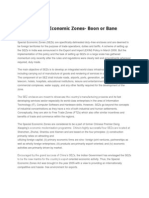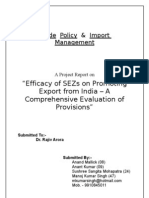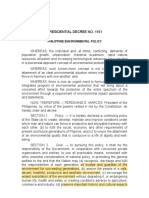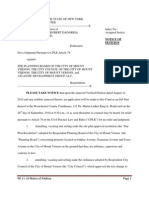0 ratings0% found this document useful (0 votes)
41 viewsS.E.Zs in India - New Avtaar of Globalization An Analytical Perspective
S.E.Zs in India - New Avtaar of Globalization An Analytical Perspective
Uploaded by
akash_shah_42This document discusses special economic zones (SEZs) in India from multiple perspectives. It analyzes the financial, economic, social, legal, and environmental aspects and implications of establishing numerous SEZs across India. Some key points discussed include the large capital investments required to develop SEZs, concerns about whether many proposed SEZs will be financially sustainable and profitable ventures, debates around the economic and social impacts of SEZs, and potential environmental issues if construction and operations are not properly regulated and managed. The document provides an analytical examination of both the opportunities and risks associated with India's ambitious plans to rapidly expand SEZs nationwide.
Copyright:
© All Rights Reserved
Available Formats
Download as PDF, TXT or read online from Scribd
S.E.Zs in India - New Avtaar of Globalization An Analytical Perspective
S.E.Zs in India - New Avtaar of Globalization An Analytical Perspective
Uploaded by
akash_shah_420 ratings0% found this document useful (0 votes)
41 views11 pagesThis document discusses special economic zones (SEZs) in India from multiple perspectives. It analyzes the financial, economic, social, legal, and environmental aspects and implications of establishing numerous SEZs across India. Some key points discussed include the large capital investments required to develop SEZs, concerns about whether many proposed SEZs will be financially sustainable and profitable ventures, debates around the economic and social impacts of SEZs, and potential environmental issues if construction and operations are not properly regulated and managed. The document provides an analytical examination of both the opportunities and risks associated with India's ambitious plans to rapidly expand SEZs nationwide.
Original Description:
385-395+
Original Title
jfg
Copyright
© © All Rights Reserved
Available Formats
PDF, TXT or read online from Scribd
Share this document
Did you find this document useful?
Is this content inappropriate?
This document discusses special economic zones (SEZs) in India from multiple perspectives. It analyzes the financial, economic, social, legal, and environmental aspects and implications of establishing numerous SEZs across India. Some key points discussed include the large capital investments required to develop SEZs, concerns about whether many proposed SEZs will be financially sustainable and profitable ventures, debates around the economic and social impacts of SEZs, and potential environmental issues if construction and operations are not properly regulated and managed. The document provides an analytical examination of both the opportunities and risks associated with India's ambitious plans to rapidly expand SEZs nationwide.
Copyright:
© All Rights Reserved
Available Formats
Download as PDF, TXT or read online from Scribd
Download as pdf or txt
0 ratings0% found this document useful (0 votes)
41 views11 pagesS.E.Zs in India - New Avtaar of Globalization An Analytical Perspective
S.E.Zs in India - New Avtaar of Globalization An Analytical Perspective
Uploaded by
akash_shah_42This document discusses special economic zones (SEZs) in India from multiple perspectives. It analyzes the financial, economic, social, legal, and environmental aspects and implications of establishing numerous SEZs across India. Some key points discussed include the large capital investments required to develop SEZs, concerns about whether many proposed SEZs will be financially sustainable and profitable ventures, debates around the economic and social impacts of SEZs, and potential environmental issues if construction and operations are not properly regulated and managed. The document provides an analytical examination of both the opportunities and risks associated with India's ambitious plans to rapidly expand SEZs nationwide.
Copyright:
© All Rights Reserved
Available Formats
Download as PDF, TXT or read online from Scribd
Download as pdf or txt
You are on page 1of 11
*Faculty, Dept. of Humanities & Management, Jaypee Institute of Engineering and Technology, Guna, M.P.
S.E.Zs in India New Avtaar of Globalization
An Analytical Perspective
Rajeev Srivastava*
Anand Rai*
Abstract
This paper tries to examine what are the hopes and fears associated with such huge infrastructure
and industry development. An analytical perspective of the SEZ framework has been
conceptualized that weather S.E.Zs is really going to enhance the nations competitiveness at the
global level, under the following aspects;
Financial Aspect: The World Bank is worried at proliferation of S.E.Zs that it is not a short-cut to
development and the large number of S.E.Zs planned across India were not 'sustainable' or 'viable'
options. One fundamental question has been lost: can S.E.Zs be a viable, profitable and
sustainable business venture? Can they earn a decent return on the thousands of crores about to be
invested at the global level? This paper attempts to capture the Break-even and risk return trade
offs in the four phases (life cycle) of S.E.Zs - Launching, Ramp-up, Payback and Annuity Phase,
respectively.
Economic Connotations: In the SEZ game , the Union commerce minister and the state
governments would like to go all out for SEZ as panacea for FDI , investment-employment
booster while , the Finance Minster is worried about the government revenues that could suffer
due to tax sops. And of course, S.E.Zs are generally blamed to create imbalances in the economy
and thus uneven income distribution. This paper critically examines upon the macro economic
aspects of S.E.Zs in reference to the economic development of the country. Further, an attempt
has been made to check the efficacy of sprawling S.E.Zs as a sustainable economic entity to
enhance global competitiveness and not as a bubble but as a reality with a different flavor and
economic connotations.
Social Aspect: Whatever the intentions of SEZ builders they are all finding land acquisition to
be extremely difficult, thereby leading to escalation in the project cost, due to delays. To an
extent, the diversity in the objectivity between industry and agriculture has complicated the issue
of conversion of green zones into the industrial activity. At this juncture, Govt as a regulatory
body is ensuring checks, inorder to rectify the imbalance so that the profitability of developers
and livelihood of the farmers is met in tandem. This paper tries to examine the socio-economic
impact assessment of S.E.Zs and also presents a critical appraisal of the policy interventions made
by the Govt of India, in this regard.
Legal Aspect: The question is what happens when large S.E.Zs eventually become townships
whose population could run into millions. There is the constitutional tenability of private
monopolies running local government for the sizable clusters of the urban population without
being elected. Would the S.E.Zs, thus, turn into sovereign states accountable to none? Or would
there be some check and balances? This paper illustrates out the issue relating to above threats,
backed up by some probable solutions.
Environmental Aspect: The SEZ units are exempted from environmental impact analysis under
the provision of the Environment (Protection) Act. Development of the SEZ would involve a
large amount of construction activity that is expected to have adverse impact on the environment
albeit temporarily during the construction phase. However if the environmental issues are not
IIMK IIML
Conference on Global Competition & Competitiveness of Indian Corporate 386
addressed during the construction phase, it could lead to irreversible damage to the environment,
at the global level.
Introduction
In the year 1991 Govt introduced the various liberalization policies reforms in order to
boost up the industrialization process in India. From last 15 years we have seen huge flow of
investments from foreign companies / institutions, which has initatited the country on the path of
globalization. But, it is only in 2005 with the advent of SEZ act, an observation and need could be
felt of real globalization. It is only after SEZ act Govt has provided level playing fields, whose
ultimate aim is not only to boost the exports, inflow of FDI but also to bring along with enormous
flow of world class latest technology inside the country. In order to cater and capture the export
markets, the major foreign players (deemed) working in S.E.Zs have to ensure the best quality of
their products and services .This quality consciousness will further enhance the technological and
R&D competitiveness of the firms in hinterland. Now, with the introduction of SEZ one can
visualize the real benefits i.e. flow of latest -state of the art technology, quality employment,
enhanced exports and thereby to unleash the vision of 2050
Thirty years ago, 80 special economic zones (S.E.Zs) in 30 countries generated barely $6
billion in exports and employed about 1 million people. Today, 3,000 S.E.Zs operate in 120
countries and account for $600+billion in exports and 50 million direct jobs. SEZ has lately been
a much talked about issue across the nation. Considering the need to enhance foreign investment
and promote exports from the country and realizing the fact that level playing field must be made
available to the domestic enterprises to be competitive globally, The Government of India had in
April 2000 announced the introduction of Special Economic Zones policy in the country. The
S.E.Zs are deemed to be foreign territory for the purposes of trade operations, duties and tariffs.
Within these zones, units may be set-up for the manufacturing goods, provisioning of services,
and other activities including processing, assembling, trading, repairing, reconditioning. The
reasons why suddenly so many S.E.Zs have mushroomed in India are easy to see. SEZ tax
concessions are generous: a 100 percent tax holiday for five years, a 50 percent tax-break for
another five years, and a further five-year tax-break on production based on reinvested profits.
SEZ developers will enjoy a tax holiday for a straight 10 years. Another feature that makes
S.E.Zs attractive to corporate is that the existing tax exemptions for export-oriented units set up in
non-SEZ areas such as software technology parks are due to expire in financial year 2009, while
S.E.Zs will enjoy the same till 2015. By offering privileged trading terms for manufacturing-
based exports, S.E.Zs can attract investment and foreign exchange, spur employment, boost the
development of improved technologies and infrastructure, and lead to tremendous economic
growth of India. Considering the immense opportunities available, states are witnessing frantic
SEZ development.
Despite their appeal, critics claim that S.E.Zs attract investment only by offering
distortionary incentives rather than building underlying competitive conditions. They also argue
that these incentives create a fiscal burden on the taxpayer and hurt environmental and labor
standards. In addition, critics believe that the direct and indirect costs of maintaining zone
privileges do not benefit the rest of the economy and, instead, lead to enclaves of prosperity.
There is a growing feeling among various segments of business and industry that so many S.E.Zs
might not see the light of the day and most of these projects will end up being mere real estate
deals for realtors or big industrial houses promoting them. There is no doubt that so many S.E.Zs
in the region will invite industry from not only within the country, but also multi-nationals from
overseas. But the real apprehension is that will so many S.E.Zs actually come into existence? Or
will some companies take this opportunity to get land at cheap prices and later use or sell it for
purpose other than for which it has been allotted. The issue of misuse of S.E.Zs status apart, even
if half the numbers of S.E.Zs come into existence, this will emerge as a tremendous opportunity
in terms of growth for real estate in the region. It is increasingly being felt that an effective
IIMK IIML
Conference on Global Competition & Competitiveness of Indian Corporate 387
compensation, resettlement and rehabilitation policy should be in place for land ousters of
industrial projects.
Financial Issues
This will be perhaps corporate Indias biggest investment rush. At the moment, over 400 SEZ
projects are ready to take off. Reliance Industry is pumping in Rs 30000 crore into two SEZ in
Maharastra and Rs 40000 crore into a third in Harayana; DLF is investing over Rs 31000 crore in
four units in Amritsar, Ambala, Ludhiana and Gurgaon; and DS group has a Rs 12000 crore plan
for two SEZ in Harayana and HP. Together they hope to buy, develop and lease out over 300000
hectares of land. These SEZ will house factories, IT parks, Office space, warehouses, Residential
apartments and malls. All that will call for a cumulative investment of Rs 330000 crore. Some
Infrastructure consulting firms put this figure at Rs 550000 crore. But amidst all that hype, one
fundamental question has been lost: can S.E.Zs be a viable, profitable and sustainable business
venture? Can they earn a decent return on the thousands of crores about to be invested? Lets take
a look at the financial issues involved in setting up a SEZ.
Finance requirement for a World scale SEZ:
Land: At least 5000 hectares
Heads Cost ( Rs Crore )
Land acquisition and development 9325
2000 MW Power Plant 8000
Desalination Plant 800
Small Air Port with one runway 200
Port with one jetty and two berths 500
Total cost 18825
THE S.E.Z LIFE CYCLE
The life cycle of a SEZ is just like the life cycle of any product. SEZ life cycle has four phases
comprising of Launching Phase, Ramp-up Phase, Payback Phase and Annuity Phase.
IIMK IIML
Conference on Global Competition & Competitiveness of Indian Corporate 388
Phase 1 .Launching Phase
The Launching phase is where SEZ developers begin the construction and show the little
infrastructure to woo customers. This phase requires huge fund and the land is sold at a
throwaway prices or even at loss so that they can bring big manufacturing units to the SEZ.
Funding is generally taken care of by promoters as debt is not available easily. This phase
contains high business risk and low returns.
Highlights:
#Huge upfront development cost
#Show infrastructure on the ground to woo customers
#High initial discount needed to woo anchor tenants
#Land is sold at loss
#Expensive proposition to bring in co-developers at this stage
#Little social infrastructure is likely to be developed at this stage
Funding Option:
#Promoters have to fund mostly through equity
#Bank loans tough to get
#Bond issues possible
#In a market like Mumbai, 20 per cent of the project cost can be met through advances from
prospective tenants.
Phase 2. Ramp-up Phase
The Ramp phase is a growth phase for SEZ, Wherein additional infrastructure is added and
clients also show significant interest in setting up there business in the SEZ. Land is sold at
premium at this stage because of large scale built up infrastructure. In order to fund the operation,
the debt is relatively easier to access and some part of it is done through clients advances. This
phase also has higher risk but return is relatively high.
Highlights:
#Additional infrastructure will be added
#More customers show interest
#Higher premium for Land
#Co-developers become interested in participating in development process
#Large scale addition of social infrastructure like malls, housing, hotels etc
Funding Option:
#Debt is easier to access
#Some internal accruals start kicking in and help service debts
#Co-developers could bring in 20-3- per cent of project cost
#Client advances could fund 40 per cent of cost.
#Cheap dollar funds from offshore banking units become available
Phase 3. Payback Phase
Pay Back phase is like a cash cow for the SEZ developers. At this stage the SEZ brand becomes
well known in the market and land is sold almost 20 times the cost. SEZ developers can make
huge profit if more land is left for sale. Out side funding is not required as it is done through
internal accruals.
Project Highlights:
#Land prices shoot up on the back of huge demand from the customers.
#Land sells 20 times the cost
#Brand of SEZ becomes well known
#The more land you have left to sell, the bigger your profit
Funding Option:
#No equity or debt needed
IIMK IIML
Conference on Global Competition & Competitiveness of Indian Corporate 389
#Project can be funded through internal accruals
#Big profits
Phase 4. Annuity Phase:
Annuity phase is where almost all the land is sold and the development process is completed.
Only administrative and maintenance cost is required which is met through internal accruals.
Highlights:
#Development and sale of land is almost over
#Only Administration and maintenance required
Funding Option:
#Minimum funding is needed and met through accruals
SEZ builders must have the capacity to inject the capital early and wait for returns it takes a
minimum of 8 years to take the project into the payback stage. Relative appreciation of land value
will be higher than the holding cost of capital. If developers can achieve this they will make
money. This is where the serious player will score over the speculators. Their returns will be far
higher than those who parceled out there land earlier. Here an average 20-25 per cent of IRR
could easily be achieved. Factors affecting Returns: Reputation of SEZ developers, Size,
Location (i.e. Near port), Financial Back-up.
Risk Return Trade off In a Matrix Form
Economic Connotations of SEZ
In the SEZ game the Union commerce minister and the state governments would like to go all out
for SEZ as panacea for FDI and investment-employment booster and the Finance Minster is
worried about the government revenues that could suffer due to tax sops. S.E.Zs are again in the
news and this time not as a bubble but as a reality with a different flavor and economic
connotations. The renewed interest of corporate houses in setting up SEZ has thrown the need of
getting insight about S.E.Zs and sustainable economic value created by such zones.
The purpose of the special economic zones is conceived to be acceleration of economic
development in a part of the country, mainly owing to external strategic investors, particularly by
the realization of any one or all of the following objectives: Development of a certain field of
economic activity, Development of new technological solutions and their use in national
economy, Development of export base, Increasing competitiveness of products and services,
Making use of already existing industrial and economic infrastructure, Creating new jobs, Making
use of natural resources with respect to natural environment.
The specified objectives of special economic zones suggest that the zones should be, on the one
hand, an instrument of industrial policy and, on the other hand, a significant instrument of
regional policy. One of the main objectives of the S.E.Zs is to restructure the old industrial set up
IIMK IIML
Conference on Global Competition & Competitiveness of Indian Corporate 390
of the hinterland and to attract new entrepreneur with liberal laws. The above objectives indicate
towards the creation of sustainable economic value in the economy in order to achieve higher
levels of development and human welfare.
Special Economic Zones in India can be interpreted as possible catalysts for transition from a
planned to market economy. The catalytic role of S.E.Zs has two facets. First, S.E.Zs positively
contribute in achieving the objective of export led growth by facilitating the inflow of foreign
direct investment (FDI) in the country. As one of the central problems of developing economies is
lower level of investment, today, in their pursuit to pick up the investment in the economy, these
countries are trying to lure the foreign direct investors through various incentives.
SEZ is a concept in this direction. SEZ being conceptualized on an integrated format helps in
attracting large amounts of FDI. Simultaneously, domestic investment also gets attracted to the
S.E.Zs. The renewed interest of big business houses of India in S.E.Zs is an indication to it.
Increased investment activity results in more economic value addition and output in the economy
upfront as well as through multiplier mechanism.
Second, for the Northern and Central States of India that are lagging behind the coastal states in
terms of industrialization as well as investment (including domestic and FDI) and resulting low
growth in State Domestic Product, S.E.Zs may play the role of catalyst to reverse this trend of
economic slugging in these States.S.E.Zs are conceptualized to have a diversified bundle of
economic activities spanning from services to various industry verticals and even more
diversified individual activity components in each industry vertical having strong linkages with
the existing industrial clusters in the hinterland. Such a conceptualization of SEZ fetches the
following potential benefits:
Speeding up the slugging economic activity in the hinterland through strong backward linkages
with local industrial clusters and forward linkages with the global markets. S.E.Zs prove
economically advantageous to all stakeholders involved- workers, firms and the region as a
whole. The local industrial clusters become good places for skilled workers. With the growth of
industrial activity (induces by SEZ) in these clusters workers with relevant skills will have more
opportunities to change employers and to pick jobs that suit their professional aspirations. Thus
IIMK IIML
Conference on Global Competition & Competitiveness of Indian Corporate 391
S.E.Zs by speeding up the economic activity and resulting increase in employment opportunities
leads to welfare of the workforce in the hinterland.
S.E.Zs having interface with the global markets benefits the firms in existing industrial clusters in
the hinterland in two ways. First, they generate the demand for the produce of these firms as an
export plank and thus help them to benefit from the external economies emanating from the
regional industrial clusters in terms of availability of a large pool of trained workers, the
circulation of information through face-to-face contacts, and the existence of supporting
industries. Second, they play the role of a gateway for flow of information and knowledge
between global markets and local industry in the region.The fallback of activation of S.E.Zs and
hinterland specific linkages translates in to benefits to the regional economy. Regions with
industrial clusters often prosper because they attract companies from outside the region also and
promote entrepreneurial activity.
S.E.Zs are generally blamed to create imbalances in the economy and thus uneven income
distribution. On the face, it may seem logical in the short run, but in the long run the development
process that is speeded up by S.E.Zs through their role as catalysts ultimately results in increased
incomes and economic well-being leading to elimination of mass poverty.
S.E.Zs benefit the society in various ways. The investment potential for S.E.Zs is expected to
create new jobs within S.E.Zs plus the hinterland. Although, the S.E.Zs are conceptualized as an
entirely market oriented business proposition, but the economic activities in the SEZ having
strong backward and forward hinterland linkages, provide an impetus to the investment and thus
employment in the hinterland through investment and employment multiplier mechanism.
Increased economic activity in the domestic tariff area leads to an increase in the earning per
capita and thus well-being of the masses.
S.E.Zs, having interface with the global markets, attract latest technology and business know-
how. This inward flow of knowledge ultimately, percolates to the locals of the hinterland; and
thus, widening their sphere of knowledge and capability that in turn translates to improved
economic and social well being.
Keeping in view the increasing concerns about the sustainability of the existing production
systems and the likely course of economic development on the earth, S.E.Zs may generate
sustainable value if conceptualized and planned comprehensively as a system based on sound
sustainability principles encompassing economic, social and environmental sustainability. The
economic activities proposed within the zones should have minimum adverse impact on the local
environment and society. On the other hand, they should benefit the society in tremendous
quantum. Thus, S.E.Zs should be envisaged as a self-sustaining value creation proposition.
Social Issues
The 432 SEZ builders together hope to acquire over 300,000 hectares (1 hectare =2.5 acre). But
on the ground, very little progress is being made. The issue of conversion of green zones into the
industrial activity may pose a problem. Whatever the intentions of SEZ builders some of these
see this as a long term infrastructure business, but many see it as a quick-return realty play- they
are all finding land acquisition to be extremely difficult, leading to escalation in the project cost ,
on account of delays. Moreover now farmers have launched an angry agitation seeking a market
price for their land during the acquisition process of proposed S.E.Zs, further leading to land
procurement costs. The Centre would be ill-advised to underplay farmers agitation in Singur and
Nandigram against their land appropriation for SEZ, or for that matter similar protests for like
purpose in other states like Punjab and Maharashtra as localized issues involving some groups
and political parties that would like to fish in troubled waters.
The present SEZ hiccup is a fall-out of bad land acquisition policy and politics. What Now, this is
likely to change as the wisdom has dawned on the government for the need to study all
ramifications, including land survey, rehabilitation of affected families, and a broader
IIMK IIML
Conference on Global Competition & Competitiveness of Indian Corporate 392
social/environment impact assessment before the S.E.Zs are approved. This could affect some
166 SEZ proposals that have received in-principle approvals and 86 that were to be deliberated by
the Board of Approvals (BoA). All the same, the corrections in the policy are a welcome
reflection of the imperative for wider popular support that is driven by the inevitability of facing
the multitude of electorate every five years. One way to achieve this is to let the displaced reap
some benefits of the development and this can be done by giving them developed land for
agriculture. For instance, 2 per cent of all land acquired should be kept aside to be developed by
the SEZ developer and allotted as residential / commercial land on a proportional basis to the
persons from whom the land has been acquired and other displaced persons. This can be done
alongside the physical displacement so that resettlement is immediate. The values of such allotted
commercial / residential developed land would rise with the value of the SEZ development
resulting in appropriate compensation truly a win-win situation
Secondly, behind this faade there is the larger issue of neglect of agriculture and allied activities,
which support over three-fifth of the population. If real investment in agriculture grows at a
pathetic 1-2 per cent, that too largely at the inefficient government instance, the sector is fated to
grow at 2-3 per cent (barring some volatility) only, a poor match to 9-10 per cent growth of
industry or services that is at the centre of all policy matters, be it in FDI, investment or enabling
environment. But then, it is also theorised that in development, agriculture that conceptually
finances investment in industry and services is destined to play a marginal role as growth driver.
And this would per se lead to widening income disparities.
Lastly, the present National Policy for resettlement and rehabilitation of Project Affected
Families (NPRR-2003) has been in force since February 2004, much before the enactment of the
SEZ Act in 2005. Moreover, several states like Orissa, MP, Maharashtra and so on have their own
rehabilitation policies offering better benefit levels to the affected families. Is it, therefore,
justified to put on hold all SEZ applications pending a new rehabilitation policy? Rehabilitation
of the affected families, no doubt, should be the top priority and responsibility of the SEZ
developer and the respective state governments. But we need also to be careful that we do not
continuously send wrong messages to global investors. We must break the pattern of sending out
messages of a in conducive policy environment, which in the past has often deprived the country
of great opportunities. Once bitten twice shy. MIDC has appointed the Karve Institute of Social
Sciences to carry out a social impact report for the area identified for SEZ development by Pune-
based Bharat Forge. The institute will suggest rehabilitation packages for farmers, up gradation of
existing industrial training institutes (ITIs), and job opportunities for farmers. A core team is
being formed at the MIDC to supervise timely implementation of the packages for farmers and
the SEZ project. Similar studies will be carried out for other SEZ projects to do a comprehensive
social assessment study and suggest appropriate rehabilitation packages.
Legal Implications
There is an old proverb-cross the river by feeling the stones which means it carefully. As we
gingerly tread the path to economic prosperity, our democracy is what is holding us together. We
do have a system of check and balance- however inefficient it may seem to an outsider or a
layman. Almost 60 years ago, India persuaded 565 princely states, most of them medieval era
kingdoms, to join the young nation in a federal structure that would be governed by the
constitution. Off late reverse appears to be taking place. The country is being carved up into new
sultanates, replete with the trapping of the modern state but run by corporate pashas more
powerful than the democratically elected representative of the Indian Republic.
It can be criticized that SEZ being protected by powerful legislation, violate the sprit and guiding
principles of the Indian constitution and hence the S.E.Zs herald a paradigm shift. Scan the SEZ
act of 2005 and it becomes clear that the S.E.Zs are a class apart. Their exalted status is
guaranteed in clear terms by both the central and state governments but more so by the later,
which has fleshed out in bold terms what the central law only hints at (see worries).
IIMK IIML
Conference on Global Competition & Competitiveness of Indian Corporate 393
Thus on a number of critical matters(environment, labor and electricity among others)
that are state subjects or fall in the concurrent list of powers shared by the central and state
governments, the states give free reign to developers of S.E.Zs. States such as Maharashtra,
Andhra Prade3sh and Uttar Pradesh have their own S.E.Zs policies and different set of rules
governing their pieces of legislation. For example: while the Congress dropped the initial
provision for granting flexibility in labor laws and thus bought piece with its left allies, the states
went ahead and amended various laws such as the contract act, Industrial Dispute Act etc, since
labor is a state subject.
Worries
Section 49 of the SEZ act 2005 empowers the government to exempt any or all S.E.Zs from the
operation of any central law through a notification. It puts S.E.Zs, theoretically at least, out side
the pale of the constitution.A wide range of services from water supply to disease control and
vital certification (birth, deaths) will be provided by private companies, which are not
accountable to the people.Several provision of the Industrial Disputes Act, Contract Labor Act etc
amended by the states have put labor on notice. Maharashtra has declared all units in S.E.Zs as
public utility services.In the SEZ, none of the laws pertaining to minimum wages, provident fund,
contract labor and employees State insurance will be implemented.No environmental Impact
assessment for industries in S.E.Zs, wich are also exempt from the environmental public hearing.
Power supply can get messy as generating companies in S.E.Zs can bypass the state electricity
regulatory commission.No mechanism for de notifying unsuccessful S.E.Zs, which leaves units
located in such zones in a limbo and large tracts of land locked in.
The question is what happens when large S.E.Zs eventually become townships whose population
could run into millions. There is the constitutional tenability of private monopolies running local
government for the sizable clusters of the urban population without being elected.
Would the S.E.Zs, thus, turn into sovereign states accountable to none? Or would there be some
check and balances?
But first, a little light on how these zones will function.
What the law lays down is an SEZ development authority (SDA) headed by the developers
representative and run by a development commissioner (DC) appointed by the state government-
A super bureaucrat vested with enormous power. Since SEZ are being designated industrial
townships by the states, the DC would work independently with no municipality or the third rung
of governance to oversee his functioning.
Clearly, there is an urgent national economic imperative especially given our demographics, and
what seems like an opportunity to capitalize on the current momentum. But we are also beginning
to slowly rip apart into countries, with the naxalite movement spreading across more than 30
percent of the districts. There is an 85 km. barrier fence with check points that separates
Shenzhen SEZ from the rest of the Shenzhen municipality. Is this what we want our city to look
like? These boundaries will become the contested terrain of conflict between the two India, one
globalizes and competitive, other left behind, with no tools to participate and only the rage of
dissatisfaction.
Environmental Impact assessment
The SEZ units are exempted from environmental impact analysis under the provision of the
Environment (Protection) Act. Further, the development commissioner will be empowered to
issue consent and no objection letters in consultation with the officers of the state pollution
control board. The units, which are classified as non-polluting industries, do not require a consent
letter. The development commissioner can give clearance without consulting the pollution control
board. The units are permitted to submit a compliance report for maintaining prescribed pollution
standards. Although the development commissioner has powers for a random check, the units
within the SEZ are free to follow their own methods to maintain environmental standards. The
IIMK IIML
Conference on Global Competition & Competitiveness of Indian Corporate 394
quality and quantity of electricity, an important and crucial public utility, has been given top
priority in the SEZ. The SEZ can have its own captive power plant to generate and distribute
power. The water supply and solid and sewage waste management is the responsibility of the SEZ
authority. An overview of the industries located in other S.E.Zs in the country reveals that there
are all types of industries such as software, electronics and hardware, ready-made garments,
engineering, leather products, chemicals and allied products. Development of the SEZ would
involve a large amount of construction activity that is expected to have adverse impact on the
environment albeit temporarily during the construction phase. However if the environmental
issues are not addressed during the construction phase, it could lead to irreversible damage to the
environment. The water body is expected to be sensitive to changes in quality due to proposed
disposal of treated effluent and sewage. It will therefore be required that treated effluent and
sewage be disposed off by means of a marine outfall. Apart from pollution generated from
industrial operations, increased traffic in the area would give rise to air emissions. The levels of
SPM, SO2, NO2, and CO are expected to rise. However as seen from the baseline data, the levels
of these pollutants are generally well below the prescribed AAQ standards. Increase in vehicular
traffic is not expected to significantly add to the ambient levels. Noise levels are expected to rise
in the area due to increased movement of heavy vehicles.
There are also a few units of gems and jewellery. Industries such as defense goods, explosives,
atomic substances, narcotic and hazardous chemicals are not permitted in S.E.Zs. Environmental
impact analysis (EIA) and compliance basically determines the potential environmental, social
and health impacts of a development project. It suggests how to minimise the adverse
environmental impact of implementing a project. The non-polluting units within S.E.Zs such as
information technology and service industries, desalination plants, and beach resorts would be
permitted without EIA. However, EIA is required for the SEZ as a whole. The development
commissioner will act on behalf of the pollution control board to grant consent letters and no-
objection certificates with respect to polluting industries, after consultations with the officers of
the state pollution control board. The units within S.E.Zs are not required to undergo a public
hearing process It is important to note that a private developer who wants to build infrastructure
for an SEZ is expected to invest in EIA. If he is not sure of getting approval he may not come
forward to invest in EIA itself. Further, in the absence of information on the type of industries
that are to be established within the SEZ, what will be the basis for conducting EIA? The
maintenance of ecological balance along with industrial development is required.
Conclusion
Active linkage programs, adequate social and environmental safeguards, and private sector
involvement in zone development and operation can go a long way in ensuring that the benefits of
S.E.Zs are maximized. Moreover, S.E.Zs must be seen in the context of an overall strategy to
promote private sector-led growth, rather than as a substitute for a good investment climate. The
obvious lesson for India is that we cannot simply invest in S.E.Zs and expect the benefits to
automatically trickle down to the rest of the economy. There would have to be an effort to
simultaneously remove bottlenecks that prevent the less developed parts of the economy from
tapping the benefits of globalization.
References
1. http://www.sezindia.nic.in- SPECIAL ECONOMIC ZONES
2. www.seepz.com- SEEPZ
3. www.mahindraworldcity.com- MAHINDRA WORLD CITY
4 www.commerce.nic.in DEPARTMENT OF COMMERCE
5. www.tradeforum.org - THE QUATERLY MAGAZINE OF INTERNATIONAL TRADE
6. www.eximbank.com EXPORT & IMPORT BANK OF INDIA
IIMK IIML
Conference on Global Competition & Competitiveness of Indian Corporate 395
7. Economic Survey 2006 Ministry Of Finance , Govt. Of India
8. Financial Express
9. Business Today
10. Business World
Appendix -1
Exports from Special Economic Zones:
Zone 2003-2004
(Rs. in crores)
2004-2005
(Rs. in crores)
Kandla SEZ 1018.82 1060.14
SEEPZ-SEZ 7832.81 8298.59
Noida SEZ 1534.17 4266.00
Madras SEZ 1037.96 1376.91
Cochin SEZ 298.91 462.99
Falta SEZ 825.34 569.15
Visakhapatnam SEZ 435.67 579.27
Surat SEZ 869.90 1539.72
Manikanchan SEZ --- 95.54
J aipur SEZ --- 5.27
Indore SEZ --- 55.02
Total : 13853.58 18309.00
*********************
You might also like
- Consent OrderDocument113 pagesConsent OrderLGOComplaintNo ratings yet
- Management Entrepreneurship and Development Notes 15ES51Document142 pagesManagement Entrepreneurship and Development Notes 15ES51Amogha b94% (18)
- Special Economic ZonesDocument4 pagesSpecial Economic ZonesKiran Kumar KskNo ratings yet
- Special Economic Zones 5Document6 pagesSpecial Economic Zones 5Giridhar MalnadNo ratings yet
- Special Economic Zones - Will India's Experiment Succeed?Document3 pagesSpecial Economic Zones - Will India's Experiment Succeed?Mangaram RamaswamyNo ratings yet
- Role of Special Economic Zones Towards CSRDocument12 pagesRole of Special Economic Zones Towards CSRsurindercdluNo ratings yet
- Problems of Sezs 8.1. Why Is The SEZ Policy Being Opposed?Document7 pagesProblems of Sezs 8.1. Why Is The SEZ Policy Being Opposed?Yusuf BhanpurawalaNo ratings yet
- Special Economic Zones in IndiaDocument7 pagesSpecial Economic Zones in IndiaArunKumarNo ratings yet
- VIJAYALAXMIDocument23 pagesVIJAYALAXMIMohmmed KhayyumNo ratings yet
- All Literature Review About SEZDocument19 pagesAll Literature Review About SEZKiran BasuNo ratings yet
- SEZDocument23 pagesSEZniharika-banga-2390No ratings yet
- Rakhine Thahaya - The Pros and Cons of SEZsDocument6 pagesRakhine Thahaya - The Pros and Cons of SEZsKo Gree Kyaw100% (1)
- Literature Review of Special Economic ZonesDocument8 pagesLiterature Review of Special Economic Zonesafdtynfke100% (1)
- Nitiblog11 VCDocument7 pagesNitiblog11 VCjohnNo ratings yet
- Small Scale IndustryDocument24 pagesSmall Scale IndustryvelavansuNo ratings yet
- Global Is at IonDocument6 pagesGlobal Is at IonThomas KevinNo ratings yet
- SEZDocument68 pagesSEZManoj K Singh100% (3)
- SKF India Limited: Shishir Joshipura, Managing DirectorDocument2 pagesSKF India Limited: Shishir Joshipura, Managing DirectorTasal DosuNo ratings yet
- 3d SEZ 3Document4 pages3d SEZ 3Vincenzo CassanoNo ratings yet
- Marcoz 2 CompleteDocument50 pagesMarcoz 2 Completemaaz bangiNo ratings yet
- Sez Scenario in India: January 2008Document5 pagesSez Scenario in India: January 2008hardik_lakhaniNo ratings yet
- Industrial Policies: 24 September 2015 16:46Document3 pagesIndustrial Policies: 24 September 2015 16:46Rain BarkhaNo ratings yet
- Is There A Silver Lining?: The Indian Mutual Fund IndustryDocument28 pagesIs There A Silver Lining?: The Indian Mutual Fund IndustryUtsav LokeshNo ratings yet
- Small Scale Industries or Small Scale Industrial UnitDocument49 pagesSmall Scale Industries or Small Scale Industrial UnitnandiniNo ratings yet
- Visit To MIDC JalgaonDocument9 pagesVisit To MIDC JalgaonSanjay TalegaonkarNo ratings yet
- Indian Business Environment: Ibs BDocument17 pagesIndian Business Environment: Ibs BSangeetha K SNo ratings yet
- Sezs (Special Economic Zones)Document12 pagesSezs (Special Economic Zones)anant saxena83% (6)
- Grant Thornton-Startups ReportDocument52 pagesGrant Thornton-Startups ReportMahesh PanigrahyNo ratings yet
- IntroductionDocument12 pagesIntroductionRussell MonroeNo ratings yet
- Special Economic Zones and India's Industrialisation: OpportunitiesDocument3 pagesSpecial Economic Zones and India's Industrialisation: OpportunitiesbuzzombaNo ratings yet
- Special Economic Zones: Issues & Implications: December 2008Document17 pagesSpecial Economic Zones: Issues & Implications: December 2008Anonymous cRMw8feac8No ratings yet
- Growth of Special Economic Zones (Sezs) in India: Manufacturing and TradeDocument1 pageGrowth of Special Economic Zones (Sezs) in India: Manufacturing and TradeRanvijay KumarNo ratings yet
- E&R at Glance: JANUARY 2013Document3 pagesE&R at Glance: JANUARY 2013Bhaskar ShanmugamNo ratings yet
- 18CS51 ME Module 5 NotesDocument19 pages18CS51 ME Module 5 NoteshibariseijiNo ratings yet
- Real EstateDocument48 pagesReal EstatetiwariparveshNo ratings yet
- Credit Rating For Small & Medium EnterprisesDocument47 pagesCredit Rating For Small & Medium EnterprisesKunal ThakurNo ratings yet
- Thesis On Small and Medium Enterprises in IndiaDocument5 pagesThesis On Small and Medium Enterprises in Indiacourtneypetersonspringfield100% (2)
- Small Scale IndustriesDocument28 pagesSmall Scale IndustriesMohit Gupta25% (4)
- Sez Sector in India: JANUARY 2007Document9 pagesSez Sector in India: JANUARY 2007Vaishali BaidNo ratings yet
- MNC's and Their Role in Developing Low Income CountriesDocument6 pagesMNC's and Their Role in Developing Low Income CountriesEliot TaylorNo ratings yet
- Economics ProjectDocument32 pagesEconomics Projectecuyv63No ratings yet
- The Current Status of SEZ, India: S. Chandrachud, Dr. N. GajalakshmiDocument3 pagesThe Current Status of SEZ, India: S. Chandrachud, Dr. N. GajalakshmiManisha TiwariNo ratings yet
- 130522annexure b1Document60 pages130522annexure b1Weddie MakomichiNo ratings yet
- Unit 4 Economics-Ii PPT 4Document14 pagesUnit 4 Economics-Ii PPT 4gauri sharmaNo ratings yet
- MSMEs in IndiaDocument4 pagesMSMEs in IndiaManisana LuwangNo ratings yet
- Assignment On SidbiDocument7 pagesAssignment On SidbiPratibha Jha0% (1)
- India's Policy On Special Economic Zones Under Fire: by Jake Skeers 27 October 2006Document7 pagesIndia's Policy On Special Economic Zones Under Fire: by Jake Skeers 27 October 2006Mahendra SharmaNo ratings yet
- Small Scale Industries Unit 3Document108 pagesSmall Scale Industries Unit 3Kismat SharmaNo ratings yet
- Efficacy of Sezs On Promoting Export From India - A Comprehensive Evaluation of ProvisionsDocument68 pagesEfficacy of Sezs On Promoting Export From India - A Comprehensive Evaluation of ProvisionsRajendran1987No ratings yet
- You Can't Just Snap FDI Into IndiaDocument4 pagesYou Can't Just Snap FDI Into IndiaRn BhaskarNo ratings yet
- PestleDocument17 pagesPestleyatin rajputNo ratings yet
- Rural Banking CH 12Document80 pagesRural Banking CH 12Pushpinder RanaNo ratings yet
- SakshamSaluja DM253064Document3 pagesSakshamSaluja DM253064saksham.dm253064No ratings yet
- ENTREPRENEUR Role of GovernmentDocument4 pagesENTREPRENEUR Role of Governmentakhtar0% (1)
- Be-Project Report-MsmeDocument24 pagesBe-Project Report-MsmeJabin shihab50% (2)
- Notes Unit 1Document5 pagesNotes Unit 1Shubham RustagiNo ratings yet
- Project Report: Ratio AnalysisDocument72 pagesProject Report: Ratio AnalysisShivjeet SinghNo ratings yet
- Somaliland: Private Sector-Led Growth and Transformation StrategyFrom EverandSomaliland: Private Sector-Led Growth and Transformation StrategyNo ratings yet
- Policies to Support the Development of Indonesia’s Manufacturing Sector during 2020–2024: A Joint ADB–BAPPENAS ReportFrom EverandPolicies to Support the Development of Indonesia’s Manufacturing Sector during 2020–2024: A Joint ADB–BAPPENAS ReportNo ratings yet
- Prof. Dr. Mrs. Suchitra KumarDocument37 pagesProf. Dr. Mrs. Suchitra Kumarakash_shah_42No ratings yet
- HSBCDocument62 pagesHSBCakash_shah_42No ratings yet
- Final Contract of Bauxite of Tirth - Vittrag 30.1.13Document8 pagesFinal Contract of Bauxite of Tirth - Vittrag 30.1.13akash_shah_42No ratings yet
- Index Research ReportDocument1 pageIndex Research Reportakash_shah_42No ratings yet
- Bungalow 9: Foodies Who Viewed This Restaurant Also ViewedDocument2 pagesBungalow 9: Foodies Who Viewed This Restaurant Also Viewedakash_shah_42No ratings yet
- Security Trends: What Can Be Done Using HDFC Net Banking in IndiaDocument2 pagesSecurity Trends: What Can Be Done Using HDFC Net Banking in Indiaakash_shah_42No ratings yet
- HRM Practice of HSBCDocument20 pagesHRM Practice of HSBCakash_shah_42No ratings yet
- GATT ReportDocument28 pagesGATT Reportpratik3331No ratings yet
- IndexDocument1 pageIndexakash_shah_42No ratings yet
- Snapple FinalDocument14 pagesSnapple Finalakash_shah_42100% (1)
- HSBC Bank Strategic AnalysisDocument10 pagesHSBC Bank Strategic Analysisakash_shah_42No ratings yet
- Pepsi Vs CokeDocument59 pagesPepsi Vs Cokeakash_shah_42100% (1)
- Coke Vs PepsiDocument63 pagesCoke Vs Pepsiakash_shah_42No ratings yet
- HSBCDocument62 pagesHSBCakash_shah_42No ratings yet
- HSBC Bank Strategic AnalysisDocument10 pagesHSBC Bank Strategic Analysisakash_shah_42No ratings yet
- Pepsi Vs CokeDocument59 pagesPepsi Vs Cokeakash_shah_42100% (1)
- Overview of Hydropower Potential and Energy Sector in MyanmarDocument27 pagesOverview of Hydropower Potential and Energy Sector in Myanmarmarcmyomyint1663100% (1)
- Firms Registration With NEMCDocument31 pagesFirms Registration With NEMCLiberatus DonantNo ratings yet
- Corporate Social Responsibility (CSR) To Corporate Environmental Responsibility (CER) :an India PerspectiveDocument14 pagesCorporate Social Responsibility (CSR) To Corporate Environmental Responsibility (CER) :an India PerspectiveLAW MANTRA100% (1)
- Okogho Churchill: The Socio-Economic Impact of Guinness Brewery (PLC) On Ikeja ResidentsDocument19 pagesOkogho Churchill: The Socio-Economic Impact of Guinness Brewery (PLC) On Ikeja ResidentsMorrison Omokiniovo Jessa SnrNo ratings yet
- Galloo Wind APEX - PSS Cover LetterDocument27 pagesGalloo Wind APEX - PSS Cover LetterpandorasboxofrocksNo ratings yet
- Chapter One: H.K.K & Salem Construction SDN - Bhd. C1-1Document8 pagesChapter One: H.K.K & Salem Construction SDN - Bhd. C1-1Friendly LondonNo ratings yet
- NASA Technical Paper 1750Document140 pagesNASA Technical Paper 1750reggaemusicNo ratings yet
- Assignment CEC416Document2 pagesAssignment CEC416Muhammed SaniNo ratings yet
- Cambodia National Report On Protected Areas and DevelopmentDocument150 pagesCambodia National Report On Protected Areas and Developmentyeangdonal100% (1)
- Environmental AuditDocument26 pagesEnvironmental AuditVivek Yadav100% (6)
- Philippines CDRA Risk Assessment 2013-2015 PDFDocument9 pagesPhilippines CDRA Risk Assessment 2013-2015 PDFMary Rose Jean PoaNo ratings yet
- Feasibility Study KwasaDocument73 pagesFeasibility Study KwasaSantonu SarkerNo ratings yet
- Resisting The Sell-Out of The Sunderban Biosphere ReserveDocument89 pagesResisting The Sell-Out of The Sunderban Biosphere ReserveEquitable Tourism Options (EQUATIONS)No ratings yet
- Presidential Decree No. 1151: June 6, 1977Document3 pagesPresidential Decree No. 1151: June 6, 1977Gia MordenoNo ratings yet
- Report On DamsDocument43 pagesReport On DamsNoli CorralNo ratings yet
- Site Restoration and Abandonment Guidelines FOR Petroleum OperationsDocument22 pagesSite Restoration and Abandonment Guidelines FOR Petroleum OperationsAyon RoyNo ratings yet
- Article 78 Proceeding V City of Mount VernonDocument20 pagesArticle 78 Proceeding V City of Mount VernonSamuel L. RiversNo ratings yet
- RPT-oct07Document43 pagesRPT-oct07escaflowne4002No ratings yet
- EC & CRZ Clearance For Great Nicobar Project - 11nov2022Document30 pagesEC & CRZ Clearance For Great Nicobar Project - 11nov2022DebiGoenkaCATNo ratings yet
- Memorial On Behalf of The RespondentDocument25 pagesMemorial On Behalf of The RespondentKashishBansalNo ratings yet
- Keta Port Request For Expression of InterestDocument4 pagesKeta Port Request For Expression of InterestHevie MichaelNo ratings yet
- RioPipeline2017 2087 Ibp Article Brazil Us BusinessDocument9 pagesRioPipeline2017 2087 Ibp Article Brazil Us BusinessJose Anisio SilvaNo ratings yet
- Environmental Compliance CertificateDocument2 pagesEnvironmental Compliance CertificateMario MauzarNo ratings yet
- Nepal Strategic Road Connectivity and Trade Improvement Project P170409Document178 pagesNepal Strategic Road Connectivity and Trade Improvement Project P170409kam-sergiusNo ratings yet
- Contemporary Issues in PMDocument26 pagesContemporary Issues in PMBobb Ketter0% (1)
- Compliance-Monitoring-Report (Annex 3.1) LatestDocument7 pagesCompliance-Monitoring-Report (Annex 3.1) LatestMeLodie Licudine EsquejoNo ratings yet
- Corporate Social ResponsibilityDocument9 pagesCorporate Social ResponsibilityAmalia Desti ArthaningtyasNo ratings yet
- Guidance On The Environmental Clearance Requirement-DubaiDocument186 pagesGuidance On The Environmental Clearance Requirement-DubaiPravinPrabhakarWakodeNo ratings yet
- Houses & Apartments For Rent in Bugesera-ManualDocument94 pagesHouses & Apartments For Rent in Bugesera-ManualMary LevisayNo ratings yet






































































































